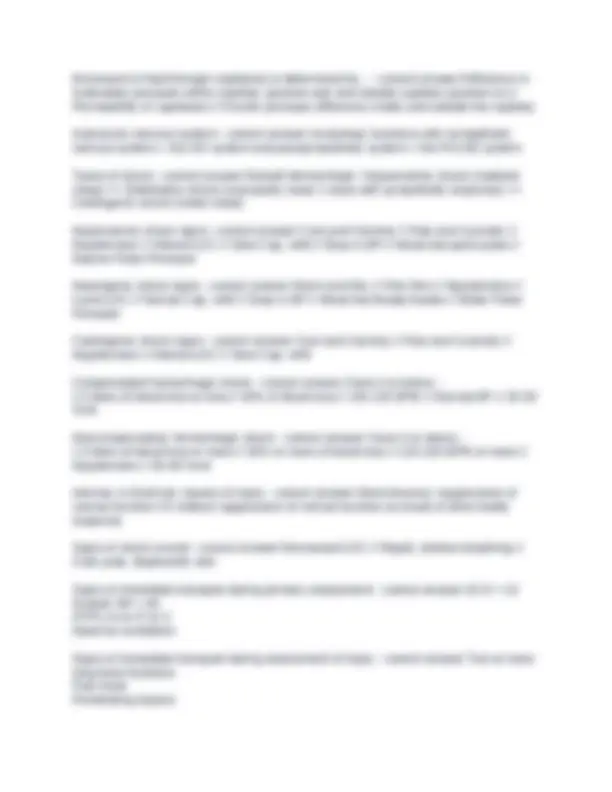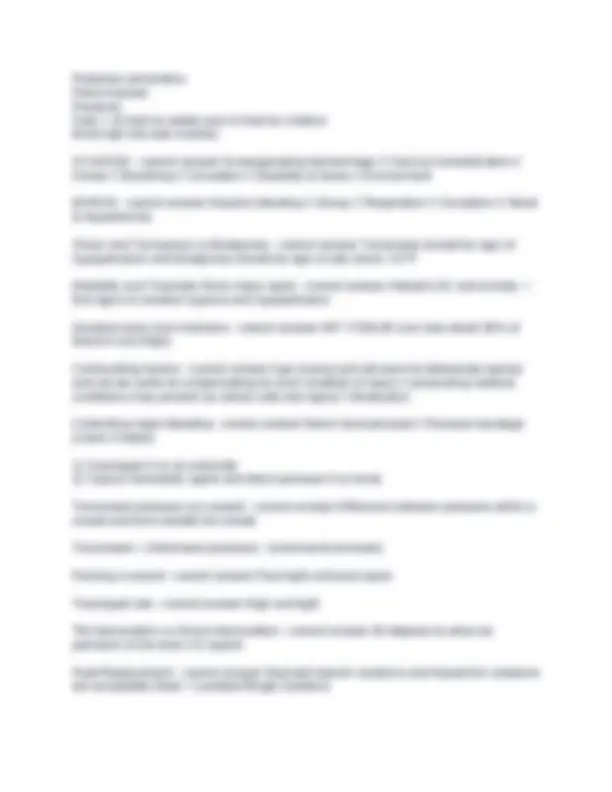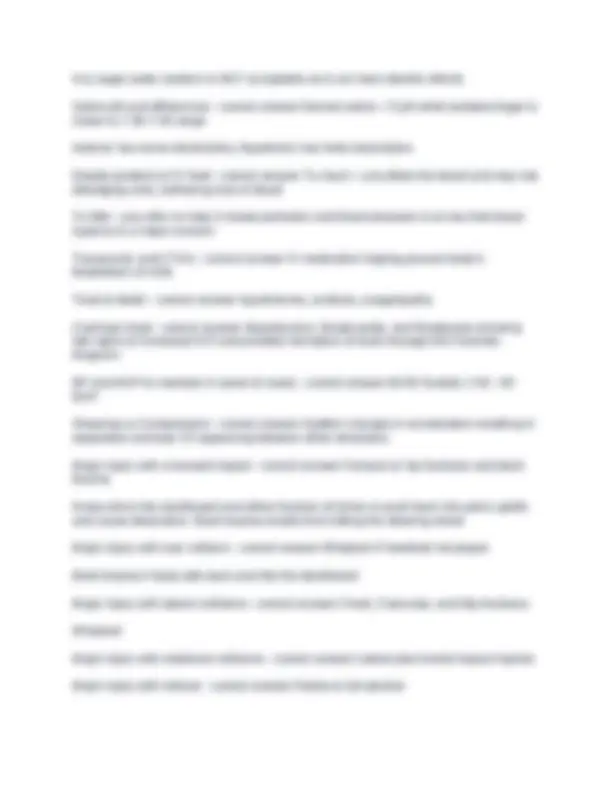






Study with the several resources on Docsity

Earn points by helping other students or get them with a premium plan


Prepare for your exams
Study with the several resources on Docsity

Earn points to download
Earn points by helping other students or get them with a premium plan
Community
Ask the community for help and clear up your study doubts
Discover the best universities in your country according to Docsity users
Free resources
Download our free guides on studying techniques, anxiety management strategies, and thesis advice from Docsity tutors
PHTLS questions and answers 2023 updated
Typology: Exams
1 / 8

This page cannot be seen from the preview
Don't miss anything!





Principles vs Preference - correct answer Principle describes the "what" of care and preference describes the "how" of care. Ethical Principles: - correct answer Nonmaleficence, Beneficence, Autonomy Justice = Do no harm, Do good, Right to consent / refusal, fair distribution of goods / services Advanced Directives & Order of Importance - correct answer Means of patient making medical decisions in advance in case of incapacitated condition; Order for life sustaining treatment (POLST) / Out of Hospital medical order / DNR order >> Medical Power of Attorney (MPOA) >> Living will Golden Hour / Period - correct answer Short period of time from injury to definitive care after which chance of survival is significantly lower; We abide by the Platinum 10, where we transport within 10 minutes of arrival Why Trauma Patients Die - correct answer Massive acute blood loss > Injury to vital organs > Airway obstruction and ventilatory failure Golden Principle #1 - correct answer Ensure Safety of Care Provider and Patient (Scene Safety / BSI) Golden Principle #2 - correct answer Assess scene for need of additional resources Golden Principle #3 - correct answer Recognize physics of trauma (how did this happen / what happened / how bad is it) Golden Principle #4 - correct answer Identify life threats (XABCDE) Golden Principle #5 - correct answer Manage Airway while ensuring C-Spine immobilization Golden Principle #6 - correct answer Support breathing Golden Principle #7 - correct answer Control significant external hemorrhages (Every Red Blood Cell Counts) Golden Principle #8 - correct answer Provide basic shock therapy such as splinting injuries and maintaining BODY TEMPERATURE
Golden Principle #9 - correct answer Determine need for spinal stabilization Golden Principle #10 - correct answer Initial transport to appropriate Trauma center Golden Principle #11 - correct answer Initiate fluid recovery Golden Principle #12 - correct answer SAMPLE history and Secondary Check Golden Principle #13 - correct answer Relieve patient pain Golden Principle #14 - correct answer Communicate patient and circumstance of the injury to receiving facility (Prearrival // Verbal upon arrival // PCR) Critical Trauma Signs - correct answer Threatened airway // Impaired ventilation // Hemorrhage // Shock of any kind / GCS < 13 // Seizure or motor deficits // Penetrating trauma to head, neck, torso. Shock - correct answer Hypo-perfusion Organ Tolerance to Ischemia - correct answer Heart / Brain / Lungs (4-6 minutes) //Kidney, Liver, GI (45-1.5 hours) // Musculoskeletal (4-6 hours) Fick Principle - correct answer Steps of Oxygenation: Loading O2 on RBC in lung, Delivering RBS to tissue, Off-loading oxygen from RBC to tissue cells How we can maintain Fick Principle - correct answer Ventilation // Maintain cardio system // Maintain body temperature Pulse pressure - correct answer Systolic - Diastolic Narrow = difference is minimal Wide = difference is wide Mean Arterial Pressure - correct answer Diastolic + (1/3) Pulse Pressure causes for hypotension - correct answer heart not filling up with enough volume or heart is filled to much and overstretch causes failure to deliver good stroke volume Edema - correct answer When we have to much fluid in interstitial space and so gap between cells and capillaries increases and we have reduced efficacy of oxygen and nutrient load / off load Oncotic pressure - correct answer Total influence of a protein and minerals on the osmotic activity of plasma water.
Pulseless extremities Pelvis fracture Paralysis Falls > 20 feet for adults and 10 feet for children Most high risk auto crashes XCABCDE - correct answer Exsanguinating Hemorrhage // Cervical immobilization // Airway // Breathing // Circulation // Disability & Neuro // Environment MARCH - correct answer Massive bleeding // Airway // Respiration // Circulation // Head & Hypothermia Shock and Tachypnea vs Bradypnea - correct answer Tachynpea should be sign of hypoperfusion and Bradypnea should be sign of late shock / GTF Disability and Traumatic Brian Injury signs - correct answer Altered LOC and anxiety = first signs of cerebral hypoxia and hypoperfusion Greatest worry from fractures - correct answer HIP / FEMUR (can lose about 30% of blood in one thigh) Confounding factors - correct answer Age (young and old seem to deteriorate quickly and old are awful at compensating for even smallest of injury) // preexisting medical conditions (may present as certain odd vital signs) // Medication Controlling major bleeding - correct answer Direct hand pressure / Pressure bandage (check if better)
Any sugar water solution is NOT acceptable as it can have diuretic effects Saline pH and differences - correct answer Normal saline = 5 pH while lactated ringer is closer to 7.35-7.45 range Isotonic has some electrolytes, Hypertonic has hella electrolytes Double problem of IV fluid - correct answer To much = you dilute the blood and may risk dislodging clots, furthering loss of blood To little - you offer no help in tissue perfusion and blood pressure is so low that tissue hypoxia is a major concern Tranexamic acid (TXA) - correct answer IV medication helping prevent body's breakdown of clots Triad of death - correct answer hypothermia, acidosis, coagulopathy Cushing's triad - correct answer Hypertension, Bradycardia, and Bradypnea showing late signs of increased ICP and possible herniation of brain through the Foramen Magnum BP and MAP to maintain in worst of cases - correct answer 80-90 Systolic // 60 - 65 MAP Shearing vs Compression - correct answer Sudden changes in acceleration resulting in separation and tear VS squeezing between other structures Major injury with a forward impact - correct answer Femoral or hip fractures and blunt trauma Knees drive into dashboard and either fracture at femur or push back into pelvic girdle and cause dislocation. Blunt trauma results from hitting the steering wheel Major injury with rear collision - correct answer Whiplash if headrest not proper Blunt trauma if body jolts back and hits the dashboard Major injury with lateral collisions - correct answer Chest, Clavicular, and Hip fractures Whiplash Major injury with rotational collisions - correct answer Lateral plus frontal impact injuries Major injury with rollover - correct answer Partial or full ejection
GCS Evaluation of Visual - correct answer 4 = immediate recognition 3 = opens to verbal 2 = opens to pain 1 = none GCS Evaluation of Verbal - correct answer 5 = Normal 4 = Confused words 3 = Random words 2 = Sounds 1 = None GCS Evaluation of motor - correct answer 6 = Perfect responses 5 = localizes the pain 4 = flexion / withdrawl 3 = abnormal decorticate response 2 = abnormal decerebrate response 1 = none Forensic Evidence and Trauma - correct answer Be sure not to cut through holes as they might have valuable info Bring all pertinent information to the hospital in a paper bag Pupils and neuro examination - correct answer We are looking for PERL eyes, Pupils Equal and Reactive to Light Communication to the receiving facility on radio - correct answer Patient gender and age MOI Serious injuries Current vitals and any major changes Interventions already performed ETA Communication the receiving facility on site - correct answer Patient gender and age MOI Serious injuries Vitals and any major changes Interventions already performed SAMPLE history (blood thinners especially) withholding resuscitation - correct answer Patient is apneic and lacks a pulse (blunt trauma) Clearly dead (decapitation)
Patient is apneic, lacks a pulse, and has no reflexive reactions